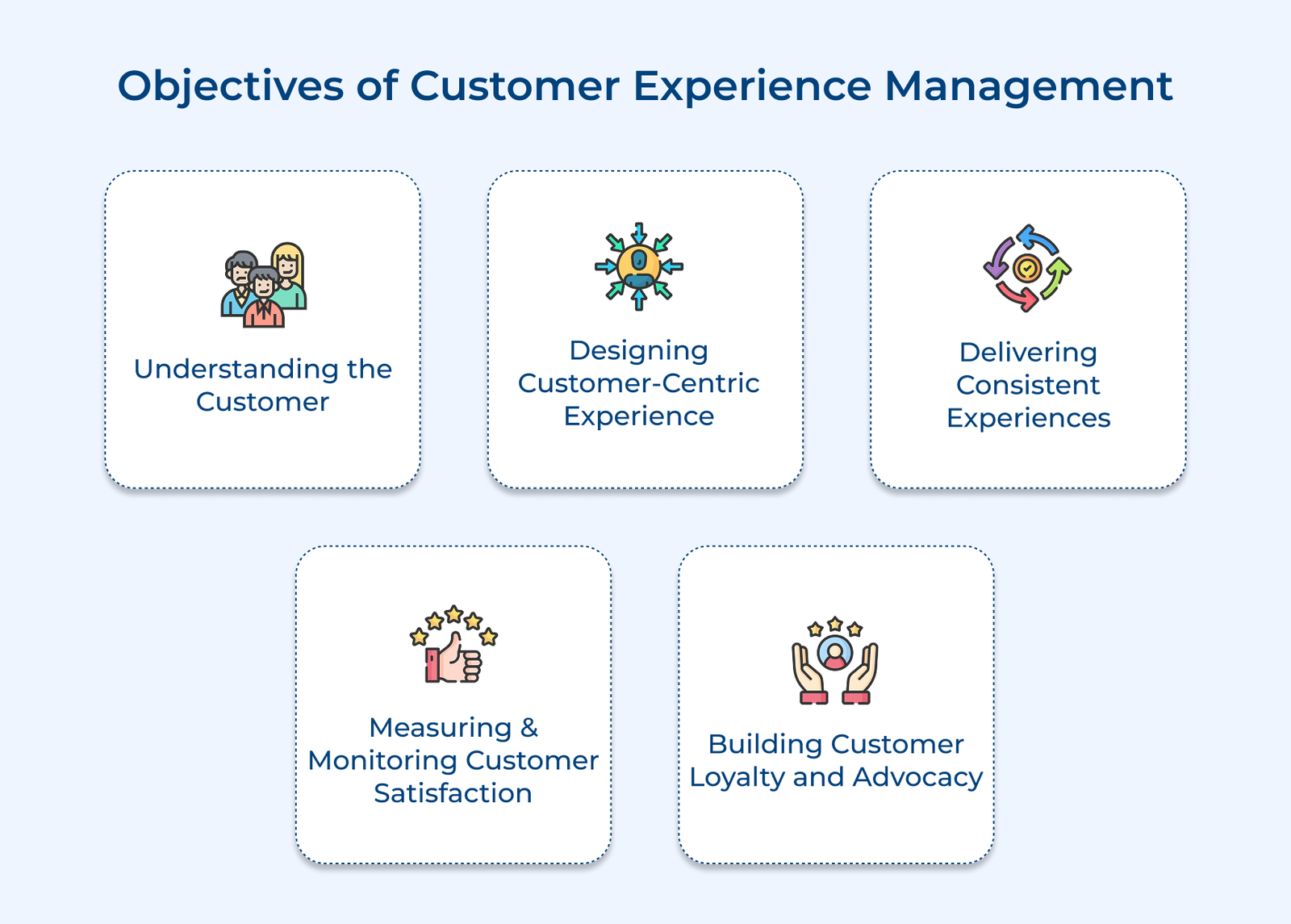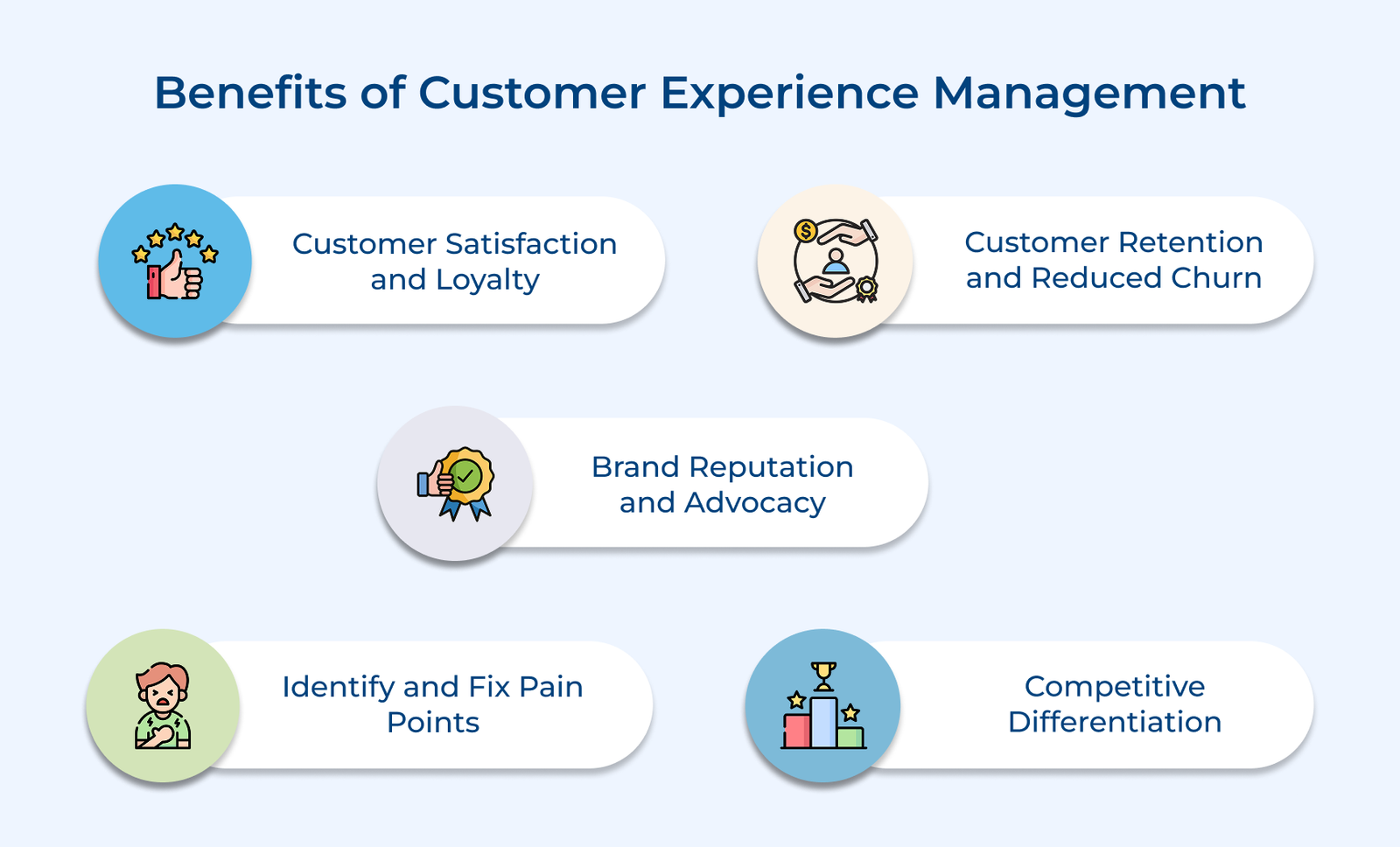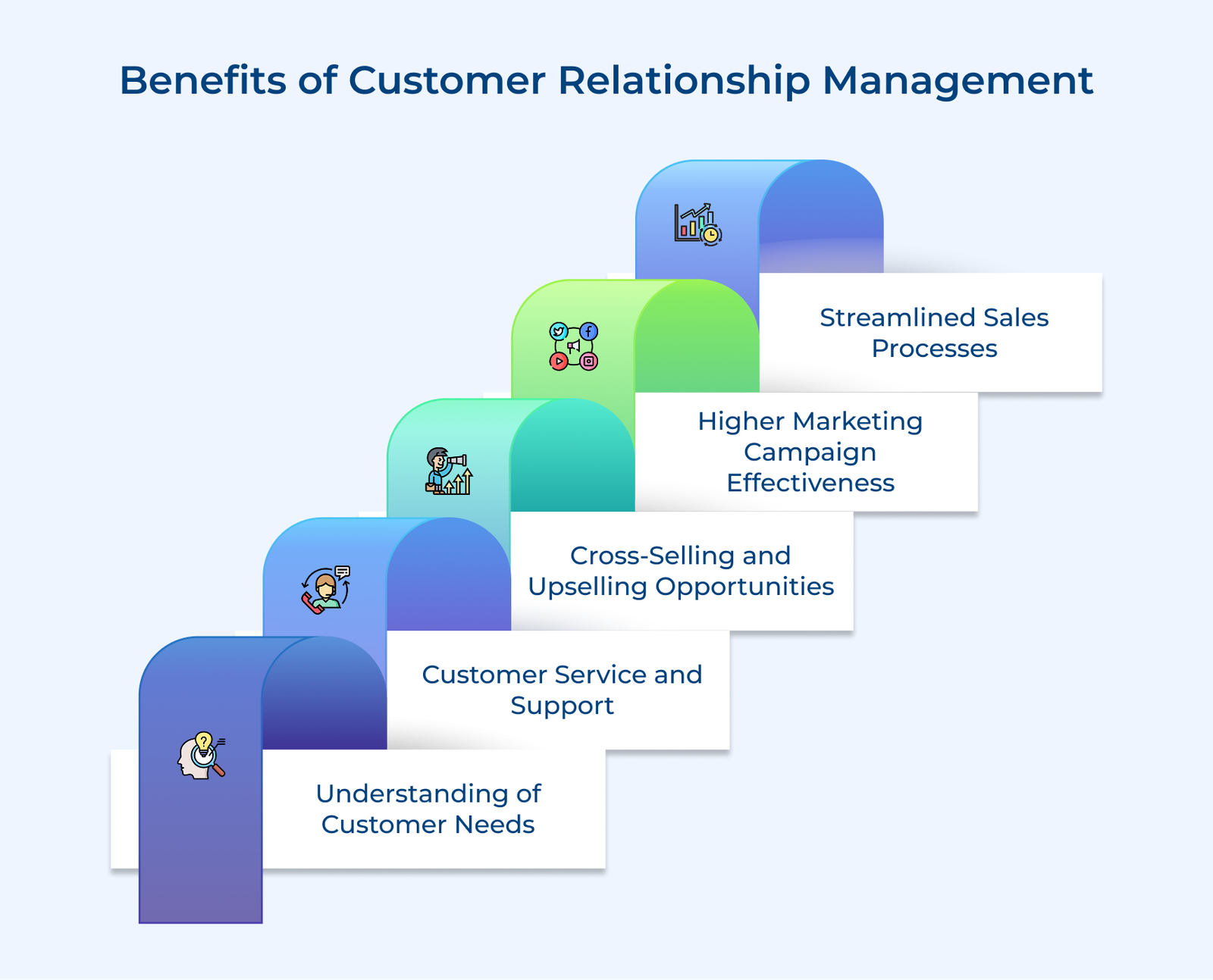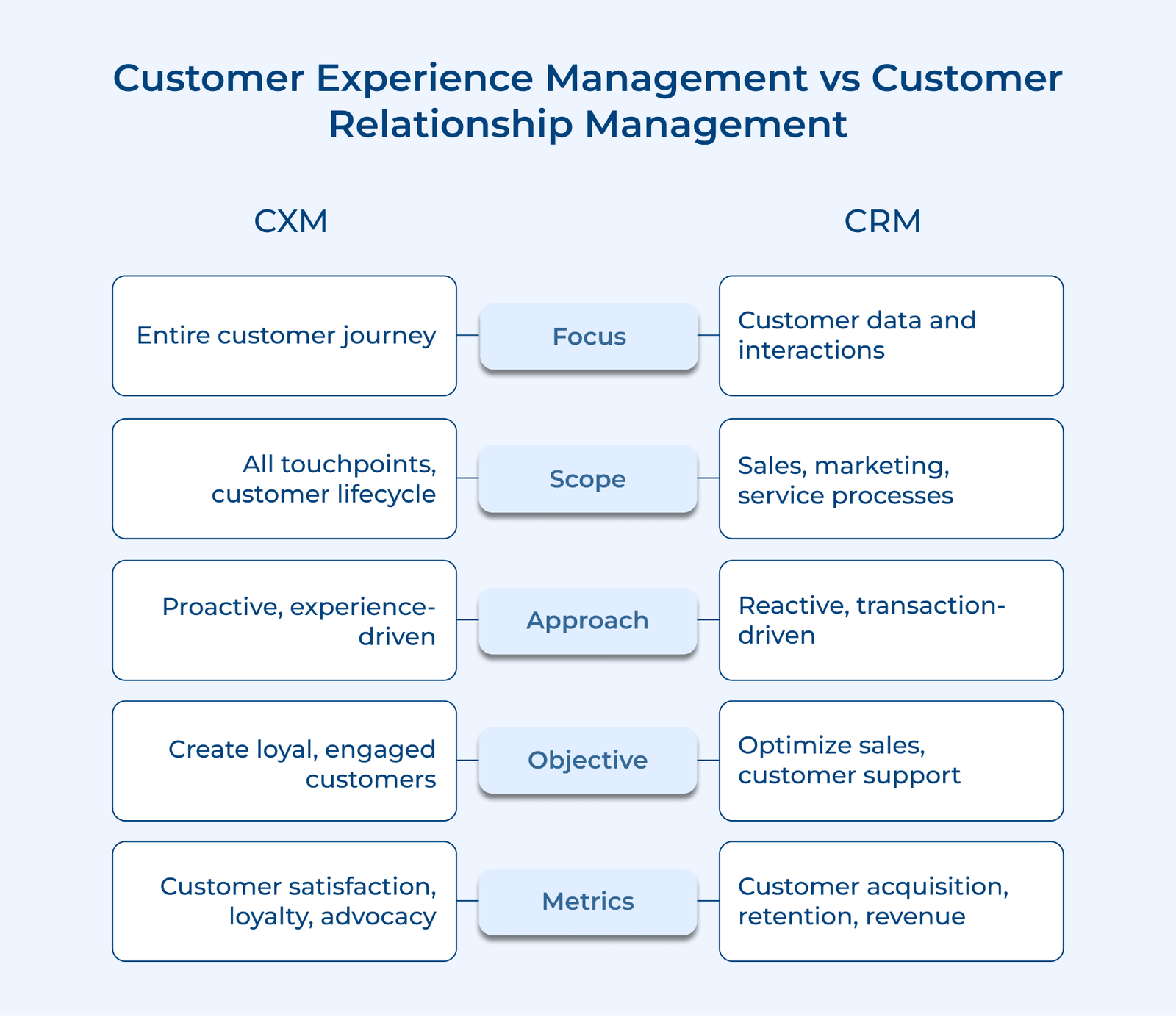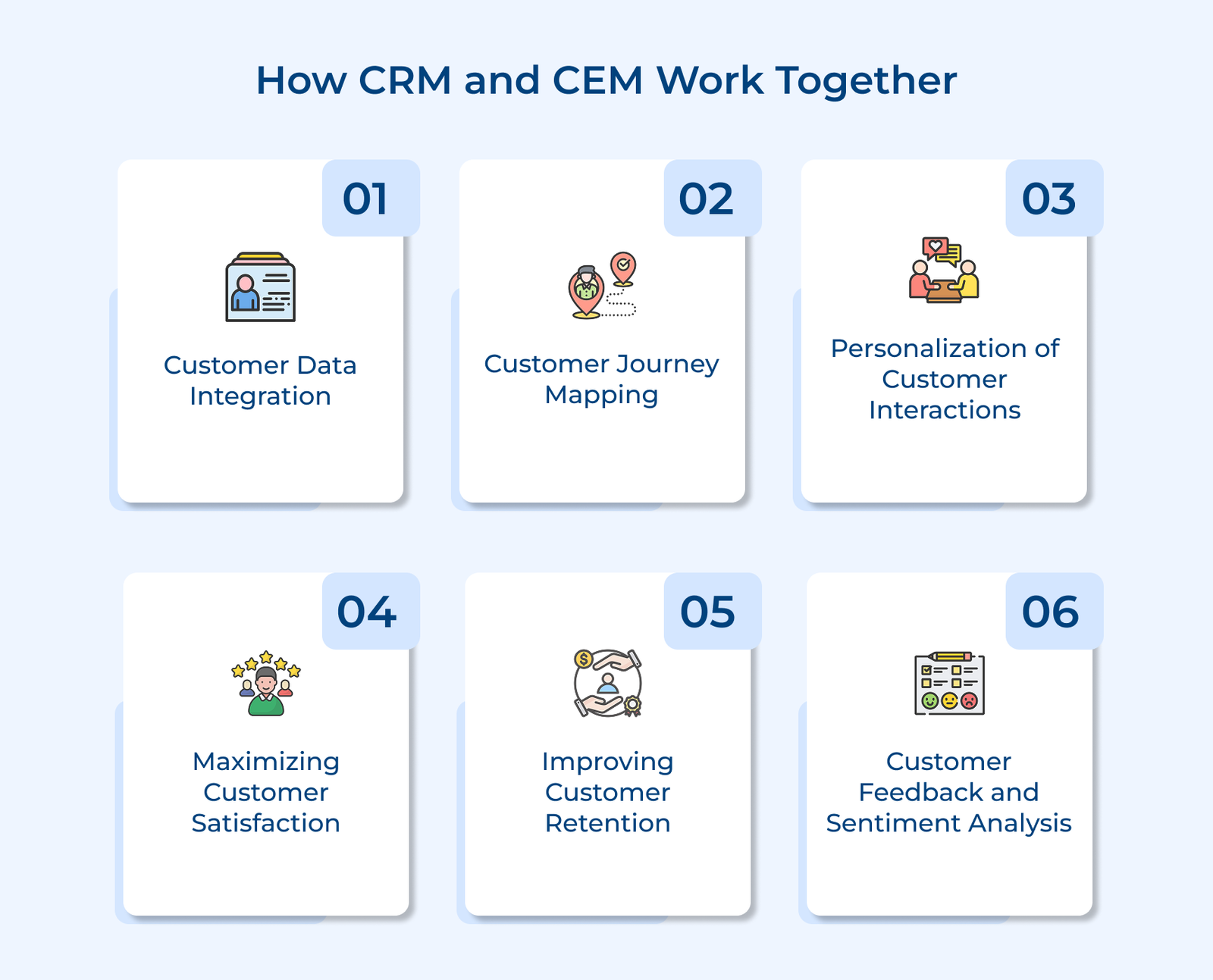1. Focus
Customer experience management (CEM) focuses on the entire customer journey, encompassing all touchpoints a customer has with a company. CEM’s primary objective is to deliver exceptional experiences that meet or exceed customer expectations. It involves mapping out every stage of the customer journey.
Customer Relationship Management (CRM) is primarily focused on managing and nurturing customer relationships. CRM’s emphasis is on organizing customer data to gain insights into customer behavior, preferences and needs. The information is then used to personalize interactions, improve customer service and enhance long-lasting relationships.
Key takeaways:
- Customer experience management is crucial for creating positive emotional connections and building brand loyalty. Customer relationship management is essential for understanding customers on a deeper level.
- CEM focuses on the “what” (the experience) and CRM focuses on the “who” (the individual customer), both are equally important for business success. Companies that integrate CEM and CRM strategies can create a powerful synergy.
2. Scope
CEM has a broader scope, encompassing every interaction a customer has with a company throughout the entire customer journey. CEM’s scope extends beyond just the core offerings, taking into account all aspects of the customer experience. It includes marketing, sales, customer service and post-purchase support.
CRM has a narrower scope, primarily focused on managing and optimizing customer relationships. The scope revolves around collecting, organizing and analyzing customer data to gain insights into customer behavior. It facilitates personalized interactions, targeted marketing and efficient customer service.
Key takeaways:
- CEM’s broader scope allows companies to create a holistic and seamless customer experience across all touchpoints. Businesses can identify and address potential pain points by considering the entire customer journey.
- CRM’s narrower scope of customer relationships and interactions enables businesses to develop a deep understanding of individual customers. The depth of knowledge empowers companies to personalize their offerings.
3. Measurement
Customer Experience Management (CEM) focuses on measuring the customer experience across multiple touchpoints and interactions. It involves evaluating various aspects such as customer satisfaction, loyalty, advocacy and perception of the brand. CEM measurement typically relies on customer feedback collected through surveys.
Customer Relationship Management (CRM) emphasizes measuring the effectiveness of customer interactions and the impact of relationship-building efforts. CRM measurement often involves tracking KPIs such as customer lifetime value, customer retention rates, cross-sell and upsell rates.
Key takeaways:
- CEM measurement is crucial for understanding the customer’s perspective and gauging the success of the organization in delivering exceptional experiences. Businesses can identify areas for improvement by capturing customer feedback.
- CRM measurement is essential for assessing the effectiveness of customer relationship strategies and their impact on business outcomes. Tracking relevant KPIs can help organizations evaluate the return on investment (ROI) of their CRM efforts.
4. Strategy
Customer Experience Management (CEM) strategy focuses on creating a holistic and consistent experience across all customer touchpoints. It involves mapping out the entire customer journey that meets or exceeds customer expectations. CEM strategy emphasizes understanding customer needs to deliver personalized experiences.
The CRM strategy is primarily centered around nurturing and strengthening relationships with customers. It involves leveraging customer data to personalize interactions, improve customer service and identify cross-selling opportunities.
Key takeaways:
- A well-defined CEM strategy is crucial for creating a competitive advantage and building a strong brand reputation. Consistently delivering exceptional experiences can help businesses differentiate themselves from competitors.
- An effective CRM strategy is essential for driving sustainable business growth and maximizing customer value. Businesses can increase customer retention, identify new revenue opportunities and optimize their operations.
5. Integration
Customer Experience Management (CEM) requires a high level of cross-functional integration across various departments and processes within an organization. CEM involves coordinating the efforts of teams such as marketing, operations and IT to deliver a consistent experience. The integration ensures that customers receive a cohesive experience.
Customer Relationship Management (CRM) primarily focuses on the integration of customer data and information systems. CRM involves consolidating customer data from various sources, such as sales, marketing and customer service, into a centralized platform. The integration enables organizations to gain a comprehensive view of each customer’s interactions.
Key takeaways:
- CEM integration is crucial for delivering a seamless and consistent customer experience across all touchpoints. The level of integration contributes to increased customer satisfaction, loyalty and brand advocacy.
- CRM integration is essential for gaining a comprehensive understanding of customers and leveraging data-driven insights. The integration leads to stronger customer relationships and increased customer lifetime value.
6. Customer Journey
Customer Experience Management (CEM) takes a holistic approach to the customer journey, focusing on mapping and understanding every touchpoint with the brand. CEM aims to deliver a seamless experience across all channels, ensuring a positive journey for the customer.
Customer Relationship Management (CRM) focuses on individual interactions within the customer journey, particularly those related to nurturing customer relationships. CRM systems are designed to capture customer data to facilitate personalized interactions.
Key takeaways:
- CEM’s emphasis on the customer journey is crucial for delivering exceptional end-to-end experiences that create lasting impressions and enhance customer loyalty.
- CRM’s ability to capture and leverage customer data from various touch points within the journey is essential for nurturing meaningful relationships.
7. Employee Involvement
Employee involvement in customer experience management is focused on creating a seamless experience for the customer at every touchpoint. Employees are trained to understand the customer journey and to prioritize the customer’s needs.
Customer Relationship Management is more about managing and maintaining relationships with customers over time. While employee involvement is still important, the focus is more on using data and technology to analyze customer interactions.
Key takeaways:
- CEM’s success heavily relies on the active involvement and commitment of employees across the organization. They are the frontline ambassadors responsible for delivering exceptional customer experiences.
- While CRM may involve a more targeted group of employees, their ability to effectively utilize customer data to nurture relationships is crucial.
How do CRM and CEM Work Together?
Discover how integrating both systems can provide a comprehensive view of customer needs and deliver personalized experiences at every touchpoint.






